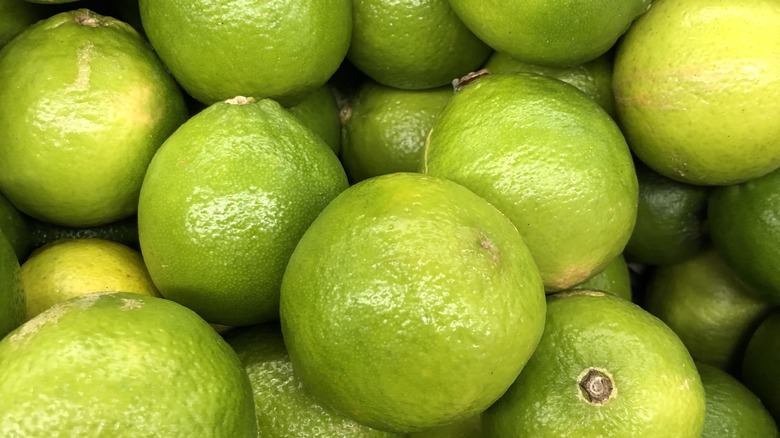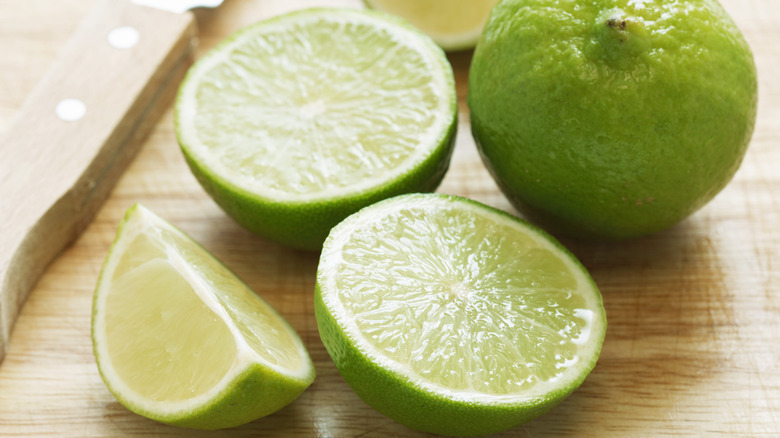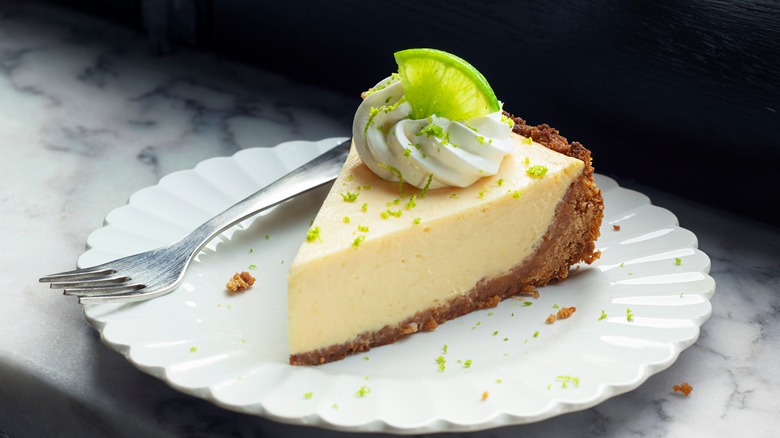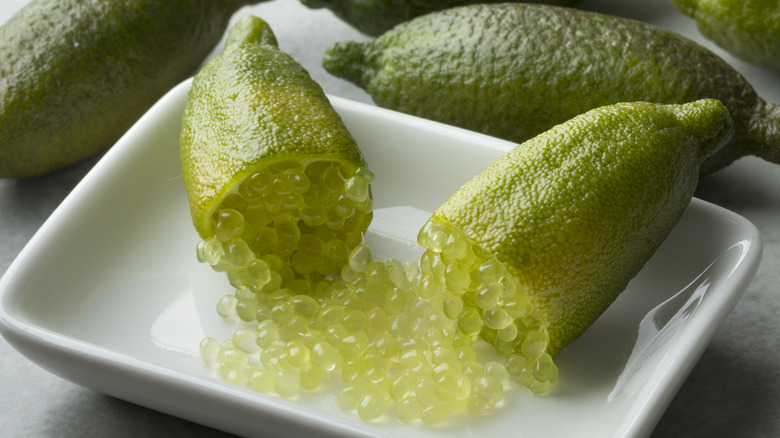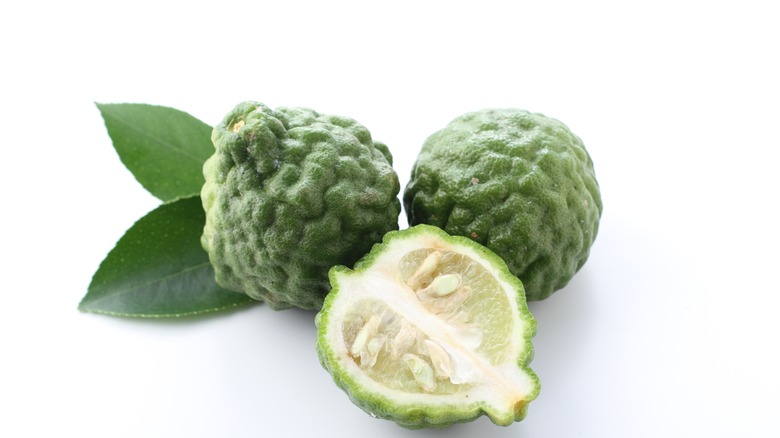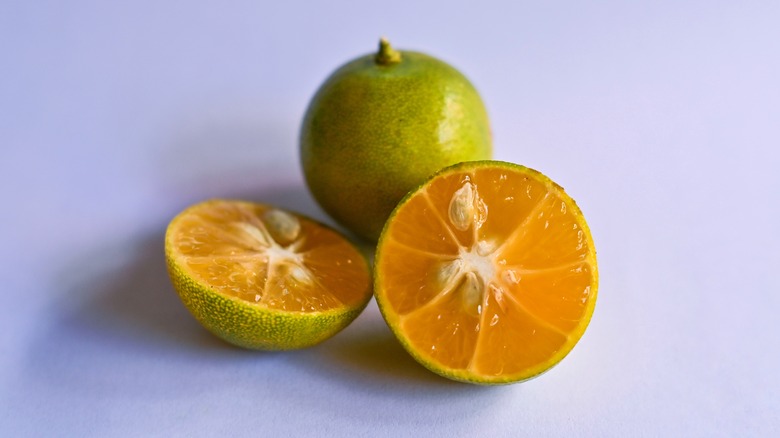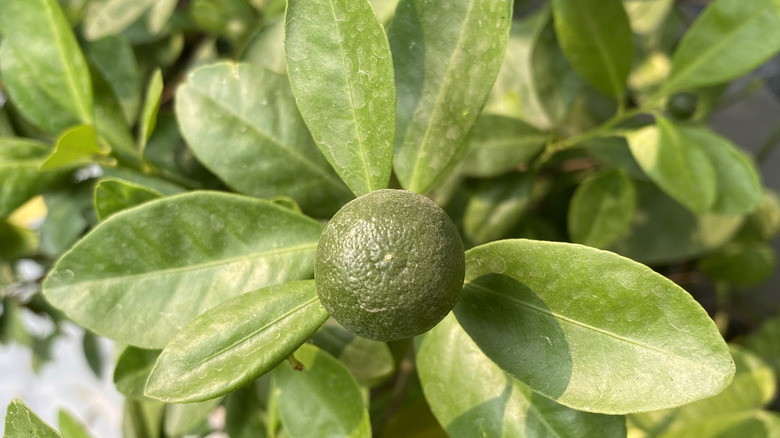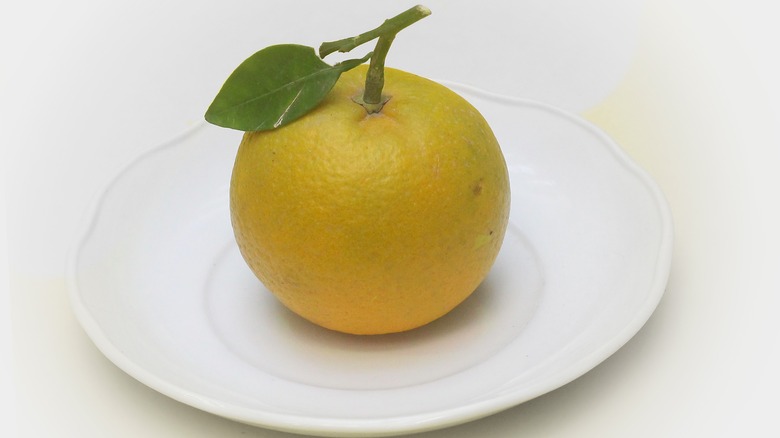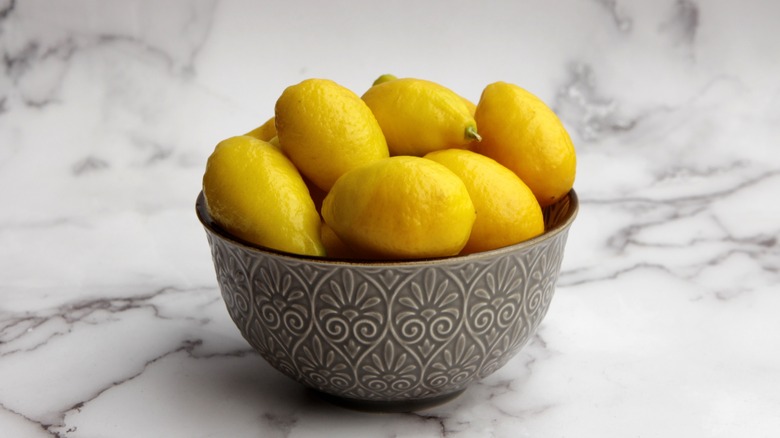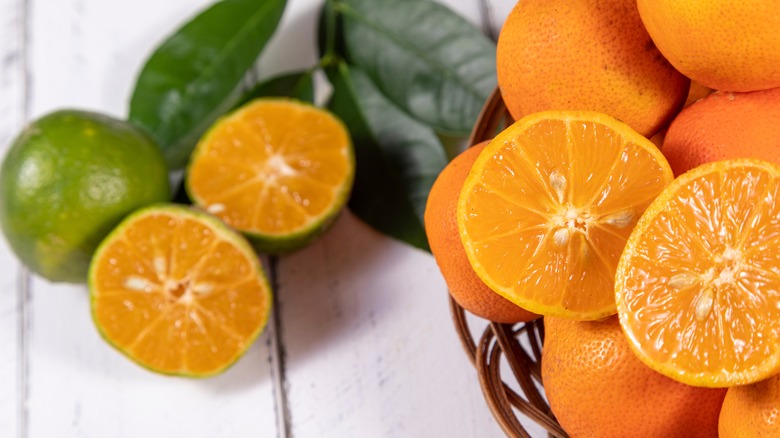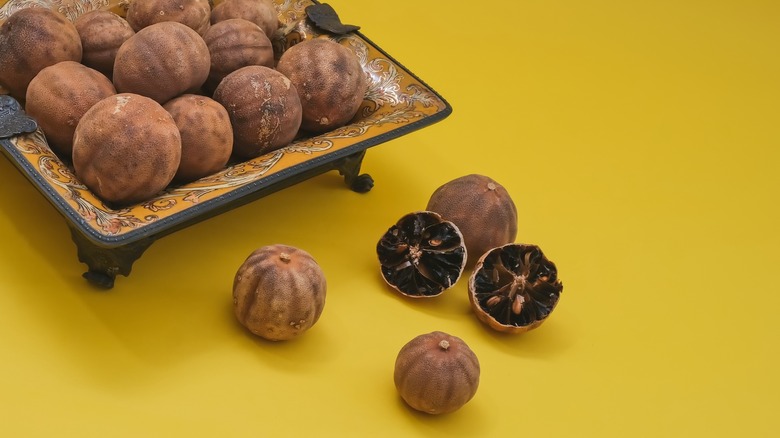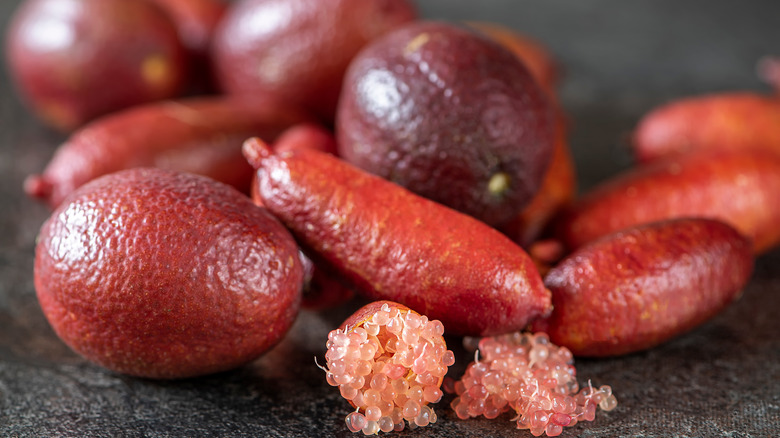11 Types Of Limes And When To Use Them
Welcome to the zesty world of limes, where this vibrant citrus adds a tangy twist to countless culinary creations. But did you know that not all limes are the same? There are multiple species of limes, all with their own flavors and uses. In this article, we'll look into distinct types of limes. Some you'll have used or heard of, but several of which are likely to be news to you.
There's the classic Persian lime that we all know and love, renowned for its juicy, seedless interior and balanced acidity. Beyond this, you have the iconic Key lime, which is known for its role in Key lime pie. We'll also delve into the aromatic wonders of makrut limes, a staple in Southeast Asian cuisine, and discover how they transform curries and soups into fragrant masterpieces. There's also time to learn about the rare finger lime, affectionately called "citrus caviar" for its unique, pearl-like vesicles, perfect for adding a burst of flavor and texture to dishes.
As we traverse through lime varieties, we'll not only explore their distinct qualities but also guide you on when to use each type. Whether you're concocting a refreshing beverage, crafting a zesty marinade, or adding a citrusy kick to your desserts, this guide will navigate you through the labyrinth of lime options, ensuring you make the most of them.
Persian limes
Meet the Persian lime, a citrus gem also known as the Tahiti lime. This is the go-to lime in the U.S. (and much of the rest of the world). So much so that you probably just know it as a lime. It was originally believed that this lime originated in Persia (now called Iran). However, it's possible that it came to California from Tahiti, hence its alternative name.
What sets the Persian lime apart is its combination of tartness and sweetness, which creates a well-balanced citrus experience. Unlike its smaller and more intense cousin, the Key lime, the Persian lime boasts a larger, seedless interior, making it a favorite among home cooks and chefs alike. When you slice through the vibrant green exterior, you reveal juicy, succulent flesh that is perfect for both food and drink.
Known for its milder acidity compared to some lime varieties, the Persian lime has become the go-to choice for cocktails, dressings, and marinades. Its ability to add a refreshing kick without overpowering the dish makes it an ideal companion in the creation of guacamole and salsas. The Persian lime's juice, whether freshly squeezed or bottled, has also become a cornerstone in the mixology world, finding its place in margaritas, mojitos, and countless other beverages.
Its journey across continents has allowed the Persian lime to seamlessly integrate into a range of cuisines, including Mexican, Caribbean, and North Indian. Its adaptability makes it a reliable partner in both sweet and savory dishes.
Key limes
Let us introduce you to the tiny dynamo of the citrus world — the Key lime. Hailing from the Florida Keys, Mexico, and other tropical regions, this little lime is bursting with flavor and has become an iconic ingredient in a variety of culinary delights.
Key limes, also known as Mexican or West Indian limes, boast a distinct taste that sets them apart from their larger counterparts. Smaller and more fragrant, these little limes pack a powerful punch of tartness, with a subtle sweetness that adds depth to their profile. When you cut through their thin, yellowish-green rind, you unveil tiny, juicy segments that are perfect for infusing dishes with a zesty kick.
One of the most famous creations featuring Key limes is the legendary Key lime pie, a dessert that strikes the perfect balance between sweet and tangy. The lime's intense flavor is showcased in this iconic pie, where its juice combines with sweetened condensed milk and egg yolks to create a creamy, citrus-infused filling nestled in a graham cracker crust.
Key limes are also the secret behind the refreshing tang of the classic Key lime margarita, adding a tropical twist to this beloved cocktail. In savory dishes, their juice serves as a flavor enhancer in marinades or salad dressings. Just remember, a little goes a long way.
Finger limes
Now it's time to take a fascinating foray into finger limes, often referred to as citrus caviar. Indigenous to Australia, these slender, elongated fruits have gained international acclaim for their distinctive appearance and remarkable burst-in-the-mouth texture. Resembling tiny, jewel-toned capsules, finger limes hail from Queensland and New South Wales. While they may be a recent discovery for many, they're well-known and commonly eaten in Australia.
What truly sets finger limes apart is their texture. When you cut open the elongated, tubular shape, you reveal tiny beads of lime that pop with a delightful juiciness. These tiny pearls burst with tangy, citrusy flavor, offering a taste that combines elements of traditional limes with subtle hints of mint and rosemary.
While you could blend them into sauces or marinades, their texture is what sets them apart, so they're usually used to top or finish a dish. They're a little like the natural version of balsamic pearls that chefs sometimes use in high-end restaurants. They're great on all kinds of dishes that need an acidic brightness, from tagines to risotto to tacos. The trouble is that they can be expensive in the U.S., costing around $10 an ounce.
Makrut limes
Enter the aromatic world of makrut limes, a citrus sensation that adds a burst of Southeast Asian flair to your culinary adventures. These limes are cherished for their intense, citrusy aroma and their leaves, which are commonly used dried. They come from the Indo-Malayan region of Southeast Asia and are particularly beloved in Thai food.
Makrut limes boast a flavor profile that is as unique as their appearance. The zest from their wrinkled, bumpy skin imparts a bright, citrusy fragrance, while the leaves, a culinary treasure, release an aromatic essence that elevates dishes to new heights. The taste of the fruit itself is intense, with a strong, tangy flavor that is a staple in Thai, Indonesian, and other Southeast Asian cuisines.
In Thai cooking, makrut lime leaves are revered for their ability to infuse dishes with a distinctive citrusy punch. They are often used in soups, curries, and stir-fries, imparting a refreshing, aromatic quality to the cuisine. The leaves are finely sliced or bruised before being added to dishes, releasing their essential oils and enhancing the overall flavor profile.
The zest of makrut limes also finds its way into many Southeast Asian dishes, where it is used to brighten up sauces, marinades, and dressings. Makrut limes have also made a mark in the mixology scene, where their distinctive flavor is used to create refreshing cocktails and mocktails. The leaves, in particular, are a popular choice for infusing syrups and spirits, adding a unique twist to beverages.
Calamansi limes
You may not have heard of Calamansi limes if you come from the U.S., but they're a staple in kitchens across Southeast Asia and beyond. Originating from the Philippines, these small, round limes pack a punch of flavor that beautifully balances sweetness and acidity.
Calamansi limes, often referred to as Philippine limes or just Calamansi, are a popular ingredient in Filipino cuisine, where their distinctive taste is a culinary cornerstone. They have a similar flavor to Mandarin oranges, but they're about equally tart and sweet, meaning they take on the same function as lemons, limes, and other tart citrus fruits. They taste a bit like oranges and a bit like limes. This is further confused by the fact that they can be either green or orange outside but are orange on the inside.
In Filipino households, Calamansi limes find their way into many culinary creations. The juice of these little wonders is a key component in the beloved dipping sauce toyomansi, which combines with soy sauce to enhance the flavors of grilled meats and seafood. Their juice is also a common addition to marinades, lending its unique citrusy kick to dishes like adobo and sinigang. Beyond the Philippines, Calamansi limes have gained popularity in other Southeast Asian cuisines, where they add a burst of citrus freshness to dishes. The juice is often used as a condiment that can be drizzled over noodles, grilled meats, and salads.
Desert lime
Desert limes are tiny powerhouses from the arid landscapes of Australia. These diminutive citrus gems, also known as Australian desert limes or bush limes, bring a unique and intense citrus flavor that has captivated both culinary enthusiasts and chefs.
Hailing from the Australian outback, desert limes have adapted to thrive in the harsh conditions of arid regions. Despite their small size — around the size of a grape — they pack a potent punch of tartness, with a distinct citrusy flavor. The aroma of desert limes is robust, and their taste is a delightful fusion of tangy and slightly sweet, making them a versatile ingredient in both sweet and savory dishes.
In Australian cuisine, desert limes have found a special place, enhancing the flavors of various dishes. Today, their juice is often used in sauces, marinades, and dressings, contributing a zesty brightness. They can also be used in dessert recipes. Indigenous Australians have long utilized desert limes as a traditional bush food. They were also turned into jams and jellies by British colonists. Essentially, you can use them in any of the same kinds of ways that you'd use a lemon or a standard lime.
Sweet limes
Welcome to the sweet side of limes. While standard limes are puckeringly tart, sweet limes are no such thing. These delightful fruits bring a mellow, honeyed twist to the classic lime experience. Sweet limes, with their pale yellow hue, have a mild, sweet flavor that distinguishes them from their more tangy counterparts. The taste is a harmonious blend of sweetness with just a hint of citrusy tang. At first glance, you might think a sweet lime is a large lemon, but it's not. It's much sweeter and with a lime-like flavor.
They're often used in Indian, Middle Eastern, and Latin American cuisine. They serve to balance the spicy, savory flavors of many traditional dishes. The juice is a popular addition to chutneys, pickles, marinades, and dressings, contributing a subtle sweetness that complements the complex spice profiles. The fruit is also enjoyed fresh, sliced, and sprinkled with a pinch of salt or chaat masala for a refreshing snack.
Sweet limes are also cherished for their juiciness and low acidity, making them a popular choice for creating thirst-quenching beverages. From sweet limeades to cocktails, their mild flavor profile allows them to blend seamlessly into a wide range of drinks. There's also the option to simply peel a sweet lime and eat it like you'd eat an orange — it's sweet enough to do so.
Limequats
A limequat isn't quite a lime but rather a citrus hybrid that marries the zesty essence of limes with the sweet subtlety of kumquats. They were first hybridized and cultivated in Florida, where many are still grown today.
Limequats can be recognized by their diminutive size and yellow hue. They're oblong and around an inch to an inch-and-a-half long. The thin, edible skin brings a burst of citrusy brightness, while the juicy interior delivers a mild sweetness. They're a mixture of sweet and tart with some slightly floral notes.
While limequats can be enjoyed fresh as a snack, they can also be added to various dishes. In desserts, limequats shine in pies and fruit salads, providing a burst of citrusy freshness. They can also be used in marinades and salad dresses. Or you can turn them into jams, jellies, and other preserves. The combination of their tartness and sweetness adds a layer of complexity to both sweet and savory dishes.
Limequats have a unique flavor that makes them a valuable ingredient in cocktails, too. From cocktails to mocktails, limequats add a touch of sophistication to your drinking experience. So whether you're exploring new citrus flavors or looking for new ingredients to use, limequats are worth a try.
Rangpur limes
The Rangpur lime is a vibrant fruit that offers its own twist to the citrus family. Originating in Bangladesh, this lime isn't your average citrus — it's a hybrid of mandarin and lemon. So, despite its limey name, it isn't a true lime at all. It doesn't look like a lime either. Rather, it has a tangerine-like appearance. It's small and orange, although it can be green outside with an orange center, depending on ripeness and growing region. Its taste is a delightful fusion of lemony tartness with a hint of mandarin sweetness. It has a slightly floral addition and a mild smokiness to its flavor, which makes it like nothing else you've tasted before.
In terms of cuisine, Rangpur limes find a home in a variety of dishes. Their juice, with its bold, invigorating profile, enhances marinades and salad dressing, creating a tantalizing balance between acidity and sweetness. The zest and juice also add a burst of flavor to sauces and desserts, showcasing the versatility of Rangpur limes in the kitchen.
Its juice adds a citrusy depth to cocktails and you can use it to infuse gin. You can also turn it into a syrup to use in alcoholic or non-alcoholic drinks, or simply juice it and drink it straight up.
Black limes
Black limes are also known as dried limes or loomi. These limes are where culinary magic unfolds through a process of transformation. Originating in the Middle East — specifically Oman — these small, sun-dried limes have a distinct appearance and flavor that can't be mistaken.
Black limes are not a distinct lime variety but rather fresh limes that undergo a sun-drying process after being soaked in brine. The result is a shriveled, blackened exterior that encases an aromatic and intensely flavored interior. The taste is a potent combination of sourness, bitterness, and a slight sweetness, with a unique fermented undertone, creating a flavor profile that's pungent and complex.
In Middle Eastern and North African cuisines, black limes are a culinary treasure. Their deep, concentrated flavor adds depth to stews, soups, and rice dishes. Whole black limes are often pierced before being added to slow-cooked dishes, allowing their essence to infuse into the entire dish, imparting a distinctive and rich taste. They're then usually removed before serving.
Black limes are also a favorite in spice blends, where their intense flavor contributes to the complex and aromatic nature of the mix. Their versatility extends to marinades and rubs, enhancing the flavors of grilled meats and vegetables. What's more, they're the key ingredient in limonana, a traditional Middle Eastern beverage.
Blood limes
Originating in Australia, specifically in the subtropical region of Queensland and the rainforests of New South Wales, blood limes are worth a mention. These little crimson gems didn't develop on their own — they were created as a hybrid of the red finger lime and the Ellendale mandarin.
What sets blood limes apart from other limes is their distinctive appearance and flavor profile. They're small, like finger limes, but slightly more rounded and less elongated. On the outside, they're either deep orange or bright red and their flesh is red, too — hence the name blood lime. Their taste marries the flavors of its parent plants — they have the sweetness of a mandarin with the tartness of a lime. The inside isn't divided into little pearls like a finger lime, but is similar to a standard lime.
You can eat blood limes straight up. Their skin is thin enough to eat, so you don't even need to peel them. However, they're also used in cooking — particularly in contemporary Australian cuisine. They're delicious cut in half and grilled on a barbecue. They can also be used in jams and other preserves and in drinks. You can squeeze their juice to use in sauces and marinades. They're also often used as garnishes. Chefs, in particular, appreciate their unique color and flavor, using them to enhance the visual appeal of their creations and add an extra kick of citrus flavor.
